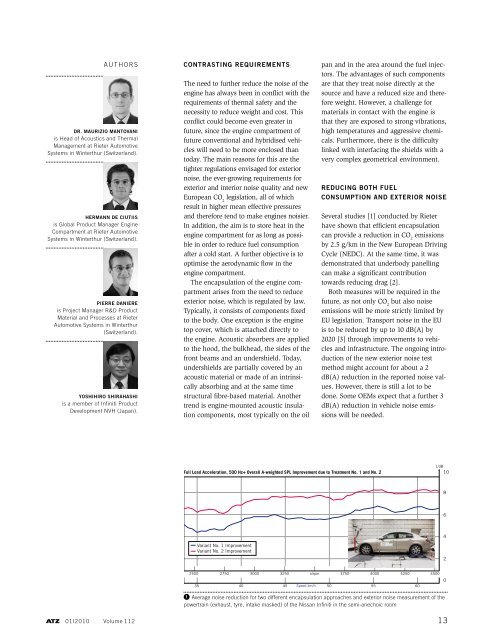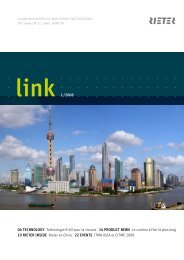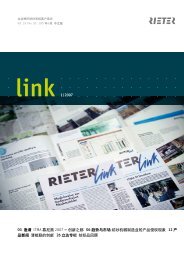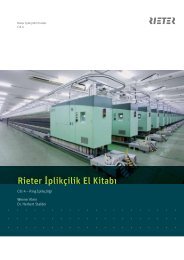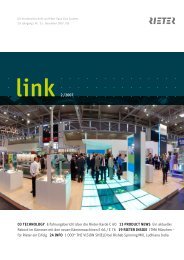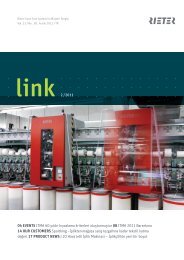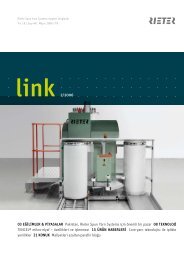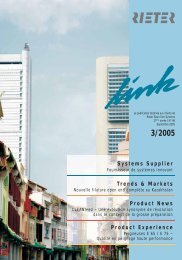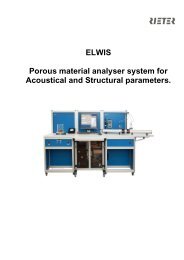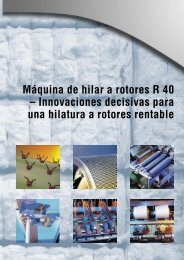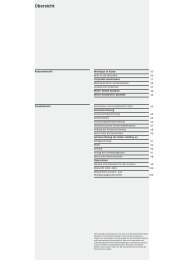Cover Story ACOusTiCs - Rieter
Cover Story ACOusTiCs - Rieter
Cover Story ACOusTiCs - Rieter
Create successful ePaper yourself
Turn your PDF publications into a flip-book with our unique Google optimized e-Paper software.
AuTHORs<br />
Dr. maurizio mantovani<br />
is Head of Acoustics and Thermal<br />
Management at <strong>Rieter</strong> Automotive<br />
systems in Winterthur (switzerland).<br />
Hermann De Ciutiis<br />
is Global Product Manager Engine<br />
Compartment at <strong>Rieter</strong> Automotive<br />
systems in Winterthur (switzerland).<br />
Pierre Daniere<br />
is Project Manager R&D Product<br />
Material and Processes at <strong>Rieter</strong><br />
Automotive systems in Winterthur<br />
(switzerland).<br />
yosHiHiro sHiraHasHi<br />
is a member of infiniti Product<br />
Development NVH (Japan).<br />
Contrasting requirements<br />
The need to further reduce the noise of the<br />
engine has always been in conflict with the<br />
requirements of thermal safety and the<br />
necessity to reduce weight and cost. This<br />
conflict could become even greater in<br />
future, since the engine compartment of<br />
future conventional and hybridised vehicles<br />
will need to be more enclosed than<br />
today. The main reasons for this are the<br />
tighter regulations envisaged for exterior<br />
noise, the ever-growing requirements for<br />
exterior and interior noise quality and new<br />
European CO 2 legislation, all of which<br />
result in higher mean effective pressures<br />
and therefore tend to make engines noisier.<br />
In addition, the aim is to store heat in the<br />
engine compartment for as long as possible<br />
in order to reduce fuel consumption<br />
after a cold start. A further objective is to<br />
optimise the aerodynamic flow in the<br />
engine compartment.<br />
The encapsulation of the engine compartment<br />
arises from the need to reduce<br />
exterior noise, which is regulated by law.<br />
Typically, it consists of components fixed<br />
to the body. One exception is the engine<br />
top cover, which is attached directly to<br />
the engine. Acoustic absorbers are applied<br />
to the hood, the bulkhead, the sides of the<br />
front beams and an undershield. Today,<br />
undershields are partially covered by an<br />
acoustic material or made of an intrinsically<br />
absorbing and at the same time<br />
structural fibre-based material. Another<br />
trend is engine-mounted acoustic insulation<br />
components, most typically on the oil<br />
Full Load Acceleration, 500 Hz+ Overall A-weighted SPL Improvement due to Treatment No. 1 and No. 2<br />
Variant No. 1 Improvement<br />
Variant No. 2 Improvement<br />
pan and in the area around the fuel injectors.<br />
The advantages of such components<br />
are that they treat noise directly at the<br />
source and have a reduced size and therefore<br />
weight. However, a challenge for<br />
materials in contact with the engine is<br />
that they are exposed to strong vibrations,<br />
high temperatures and aggressive chemicals.<br />
Furthermore, there is the difficulty<br />
linked with interfacing the shields with a<br />
very complex geometrical environment.<br />
reDuCing BotH FueL<br />
ConsumPtion anD eXterior noise<br />
Several studies [1] conducted by <strong>Rieter</strong><br />
have shown that efficient encapsulation<br />
can provide a reduction in CO 2 emissions<br />
by 2.5 g/km in the New European Driving<br />
Cycle (NEDC). At the same time, it was<br />
demonstrated that underbody panelling<br />
can make a significant contribution<br />
towards reducing drag [2].<br />
Both measures will be required in the<br />
future, as not only CO 2 but also noise<br />
emissions will be more strictly limited by<br />
EU legislation. Transport noise in the EU<br />
is to be reduced by up to 10 dB(A) by<br />
2020 [3] through improvements to vehicles<br />
and infrastructure. The ongoing introduction<br />
of the new exterior noise test<br />
method might account for about a 2<br />
dB(A) reduction in the reported noise values.<br />
However, there is still a lot to be<br />
done. Some OEMs expect that a further 3<br />
dB(A) reduction in vehicle noise emissions<br />
will be needed.<br />
2500 2750 3000 3250 n/rpm 3750 4000 4250 4500<br />
35 40 45 Speed km/h 50 55 60<br />
1 Average noise reduction for two different encapsulation approaches and exterior noise measurement of the<br />
powertrain (exhaust, tyre, intake masked) of the Nissan infiniti in the semi-anechoic room<br />
01i2010 Volume 112 13<br />
L/dB<br />
10<br />
8<br />
6<br />
4<br />
2<br />
0


